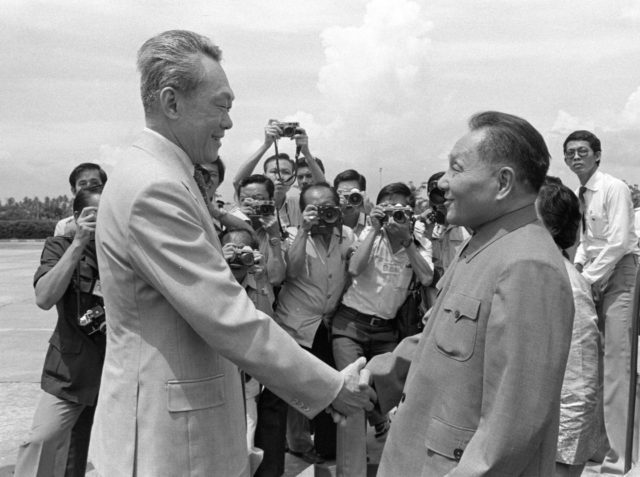
In A Fortnight: The End of the Singapore Model
Publication: China Brief Volume: 18 Issue: 5
By:

In many more ways than one, this year’s Two Sessions—an annual March meeting of China’s two highest legislative bodies—marked the end of an era. Among other developments, Xi Jinping signaled his unmatched control of the levers of power by remaking, seemingly at a stroke, China’s constitution and government, subsuming many of the latter’s functions into the Communist Party. His actions brought to a definitive close China’s era of “collective leadership”, and signaled unambiguously the opening of a period of one-man rule.
The Two Sessions also signaled the end of another era, less noticed and commented upon than Xi’s high-profile reforms: It marked the end to the usefulness of the “Singapore model” as a way of understanding China’s political evolution, for people both inside and outside China. For better or for worse, the Two Sessions underscored that Xi’s PRC now believes it has its own model to offer the world, one for which it is beholden to no one, including Singapore.
A Model City
When Deng Xiaoping began to open China to the outside world in 1978, he quickly identified Singapore as an example his country should study. The reasons were obvious: Singaporean Prime Minister Lee Kwan Yew had built a country that married efficient economic management, clean governance, and rapidly rising standards of living with an enduring one-party hold on power, all in a multi-ethnic, majority-Chinese society. In his first visit to Singapore in 1978, Deng was reportedly “shocked” by its prosperity [1]. In 1992, Deng exhorted CCP cadres to “learn from the world, especially from Singapore”, touching off a “Singapore fever” in PRC political and academic circles. The enthusiasm was institutionalized: from the 1990s to 2015, some 50,000 PRC officials made the pilgrimage southward to “learn from Singapore”. The intensity of the PRC’s focus on the Singapore model was not lost on Western academics or journalists, who probed the flourishing ties between the two for clues on China’s future direction (New York Times, August 9, 1992). People inside of China hoping for political liberalization also saw a glimmer of hope in this embrace of Singapore.
But the two countries’ mutual enthusiasm has now begun to wane, with ties sliding from respect towards suspicion, prompted by Singaporean concern over PRC assertiveness in the South China Sea and the subsequent PRC reaction. One important consequence has seen the CCP has begun to cut back the number of cadres it sends to Singapore (Global Times, June 29, 2017). The public debate in Singapore has also swung in a hawkish direction: Singaporean ambassador-at-large Bilahari Kausikan has called the PRC’s policy towards overseas Chinese communities an “existential” threat to Singapore, saying pushback is a “matter of survival” (Straits Times, July 9, 2017). Last week, Singapore’s government heard public testimony from an academic panel empowered to investigate ‘online falsehoods’ which asserted that an unnamed foreign state had “had waged information warfare against Singapore in recent months through news articles and social media, in its attempts to influence specific segments in the international sphere” (Today, March 16). Although the state actor was left unnamed, for a number of reasons the PRC is by far the most likely candidate. On Beijing’s side, official and quasi-official statements often portray the friction as a result of Singapore’s difficulty adapting to the PRC’s expectation that it be shown a deference commensurate with its growing influence.
A New Direction
In the 20/20 lens of hindsight, the deterioration of relations makes some sense, since the PRC’s enthusiasm for the Singapore model was never quite the meeting of the minds it was portrayed to be. More perceptive observers have recently noted that the version of Singapore held up as a model inside China was an airbrushed version of a much more complex picture, meant to flatter China’s leaders chosen development path. [2] Commentary by authoritative political observers in China frequently expressed admiration for how Lee Kwan Yew had managed to “concentrate the power of the state to bring about strategic development” so as to “bring prosperity and progress to Singaporean society, and provide for the [people’s] welfare”, words that seem to describe the CCP’s approach to governing as much as Singapore’s. (Beijing Daily, March 30, 2016). By the same token, Western who drew hope from the PRC’s close study of Singapore’s political institutions were often quick to note that Singapore’s ‘managed democracy’ had real opposition parties that could supervise and act as a check on government actions, an observation that reinforced their own ideas of how China could (and, in some cases, should) develop.
Xi’s NPC reforms, explored in more detail by Dr. Willy Lam in his column for this China Brief, put thoroughly to rest the notion that China will follow Singapore’s path. Rather than a managed democracy and limited state interference in the market, Xi envisions a society where everything, including government and business, submit to the guidance and leadership of the Communist Party. Hand-in-hand with Xi’s confident reassertion of Party prerogative, Chinese leaders have begun to speak of a “China model” and “Chinese wisdom”, asserting that China’s unique development path is one worthy of study, if not always emulation (China Brief, February 26). Although PRC academia and policymakers will continue to study other political systems as a matter of course, Xi has declared that China has its own model now, a reality to which Singapore, as well as the rest of the world, will have to begin to adapt.
“In A Fortnight” is a bi-weekly column by Matt Schrader, the editor of China Brief. Follow him on Twitter at @tombschrader.
Notes
[1] This anecdote is pulled from “The ‘Singapore Fever in China’: Policy Mobility and Mutation”, written by Kean Fam Lim and Niv Horesh for The China Quarterly, December 2016.
[2] See Stephan Ortmann and Mark R. Thompson, “China and the ‘Singapore Model’”, writing in the Journal of Democracy, January 2016.




